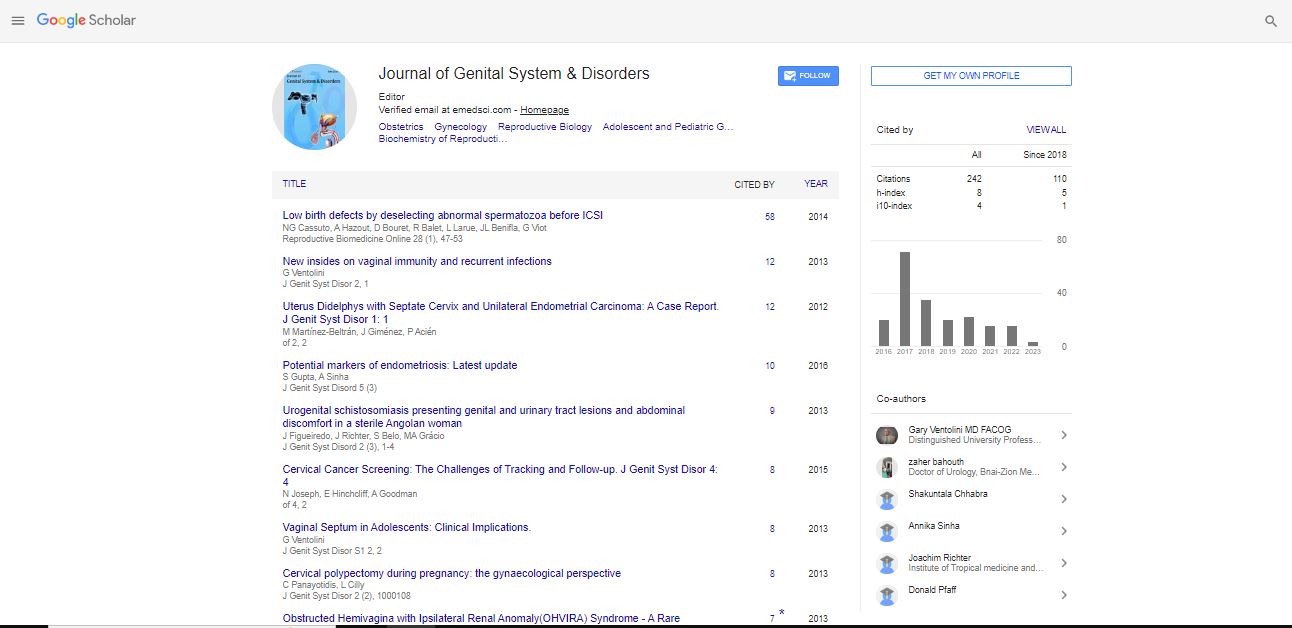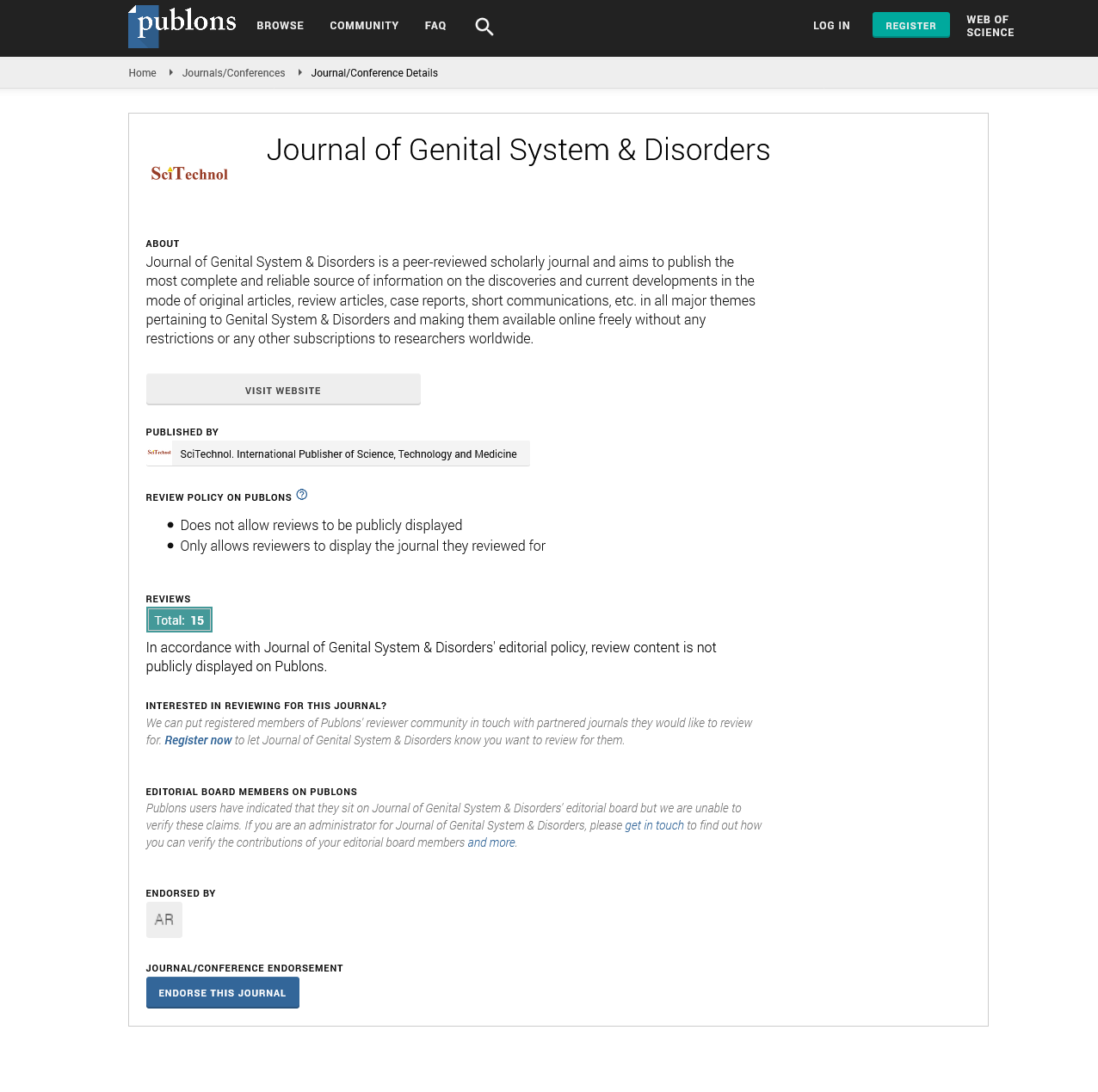Opinion Article, J Genit Syst Disord Vol: 12 Issue: 2
Advancements in Assisted Reproduction and Emerging Therapeutic Approaches
Sanjeev Roy*
1Department of Zoology, Mizoram University, Aizawl, India
*Corresponding Author: Sanjeev Roy,
Department of Zoology, Mizoram
University, Aizawl, India
E-mail: sanjevv.roy@mzu.edu.in
Received date: 22 May, 2023, Manuscript No. JGSD-23-107311;
Editor assigned date: 24 May, 2023, PreQC No. JGSD-23-107311 (PQ);
Reviewed date: 08 June, 2023, QC No. JGSD-23-107311;
Revised date: 16 June, 2023, Manuscript No. JGSD-23-107311 (R);
Published date: 26 June, 2023 DOI: 10.4172/2325-9728.1000283
Citation: Roy S (2023) Advancements in Assisted Reproduction and Emerging Therapeutic Approaches. J Genit Syst Disord 2023, 12:2.
Description
Reproductive science and therapeutics have transformed the landscape of fertility treatment, offering hope to individuals and couples facing challenges in achieving pregnancy. Advancements in Assisted Reproductive Technologies (ART) and emerging therapeutic approaches have significantly improved success rates and expanded options for patients.
Assisted Reproductive Technologies (ART)
In Vitro Fertilization (IVF): IVF is a widely used assisted reproduction technique that involves the retrieval of eggs from the ovaries, fertilization with sperm in a laboratory setting, and the subsequent transfer of embryos into the uterus. IVF has revolutionized infertility treatment and offers options for individuals with various reproductive challenges, such as blocked fallopian tubes, low sperm count, or unexplained infertility. Advances in IVF techniques, including the use of controlled ovarian stimulation, improved embryo culture systems, and blastocyst transfer, have contributed to higher success rates and increased chances of pregnancy.
Intracytoplasmic Sperm Injection (ICSI): ICSI is a specialized technique used in conjunction with IVF, where a single sperm is directly injected into the egg to facilitate fertilization. ICSI is particularly beneficial in cases of severe male factor infertility, such as low sperm count or poor sperm motility. This technique has significantly improved fertilization rates and pregnancy outcomes for couples facing male infertility issues.
Cryopreservation: Cryopreservation allows the freezing and storage of eggs, sperm, or embryos for future use. It offers options for fertility preservation in individuals undergoing medical treatments that may impact their reproductive function, such as chemotherapy or radiation therapy. Cryopreservation also facilitates embryo banking, enabling the transfer of embryos in subsequent cycles and reducing the need for repeated ovarian stimulation and egg retrieval procedures.
Preimplantation Genetic Testing (PGT)
PGT involves the screening of embryos for genetic abnormalities or chromosomal disorders before their transfer into the uterus during IVF. This technique allows for the selection of embryos with a higher likelihood of implantation and a lower risk of genetic conditions. PGT can help couples reduce the risk of passing on specific genetic disorders and increase the chances of a successful pregnancy.
Emerging therapeutic approaches
Intrauterine Insemination (IUI): IUI involves the placement of specially prepared sperm directly into the uterus, bypassing the cervix. It is a less invasive assisted reproduction technique often used in cases of mild male factor infertility or unexplained infertility. IUI offers a less complex and more cost-effective treatment option compared to IVF for select patients.
Assisted hatching: Assisted hatching is a technique used to create a small opening in the outer shell (zona pellucida) of the embryo, enhancing the embryo's ability to implant into the uterine lining. This technique is particularly beneficial for couples with advanced maternal age or embryos with a thick zona pellucida.
Ovarian tissue cryopreservation and transplantation
Ovarian tissue cryopreservation involves the freezing and storage of ovarian tissue for future transplantation. This technique offers fertility preservation options for individuals facing treatments that may damage ovarian function. Emerging research focuses on improving ovarian tissue transplantation techniques to restore fertility in these individuals.
Conclusion
Reproductive science and therapeutics have revolutionized the field of fertility treatment, offering hope and options for individuals and couples facing challenges in achieving pregnancy. Advancements in ART techniques, such as IVF, ICSI, cryopreservation, and PGT, have significantly improved success rates and expanded treatment options. Emerging therapeutic approaches, such as IUI, assisted hatching, and ovarian tissue cryopreservation, further contribute to the field's progress. Ongoing research and exploration of novel techniques and treatment modalities will continue to shape the future of reproductive science and therapeutics, providing improved outcomes.
 Spanish
Spanish  Chinese
Chinese  Russian
Russian  German
German  French
French  Japanese
Japanese  Portuguese
Portuguese  Hindi
Hindi 
